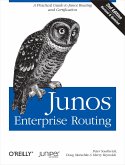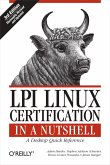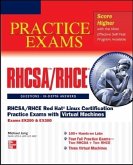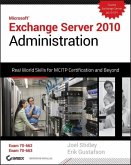Rob Cameron, Brad Woodberg, Patricio Giecco, Timothy Eberhard, James QuinnA Guide to Junos for the Srx Services Gateways and Security Certification
Junos Security
A Guide to Junos for the Srx Services Gateways and Security Certification
By Rob Cameron, Brad Woodberg, Patricio Giecco, Timothy Eberhard & James Quinn
Rob Cameron, Brad Woodberg, Patricio Giecco, Timothy Eberhard, James QuinnA Guide to Junos for the Srx Services Gateways and Security Certification
Junos Security
A Guide to Junos for the Srx Services Gateways and Security Certification
By Rob Cameron, Brad Woodberg, Patricio Giecco, Timothy Eberhard & James Quinn
- Broschiertes Buch
- Merkliste
- Auf die Merkliste
- Bewerten Bewerten
- Teilen
- Produkt teilen
- Produkterinnerung
- Produkterinnerung
This book is the complete and authorized introduction to Juniper Network's new SRX hardware series that runs the Junos operating system. You not only get a hands-on field guide to deploying, configuring, and operating SRX, but also a reference to help you prepare for the JNCIS-ES and JNCIE-ES Certification examinations. Learn how to use SRX to address an array of enterprise data network requirements -- including IP routing, intrusion detection, attack mitigation, unified threat management, and more.
Andere Kunden interessierten sich auch für
![Junos Enterprise Routing Junos Enterprise Routing]() Peter SouthwickJunos Enterprise Routing66,99 €
Peter SouthwickJunos Enterprise Routing66,99 €![LPI Linux Certification in a Nutshell LPI Linux Certification in a Nutshell]() Adam HaederLPI Linux Certification in a Nutshell37,99 €
Adam HaederLPI Linux Certification in a Nutshell37,99 €![RHCSA/RHCE Red Hat Linux Certification Practice Exams with Virtual Machines RHCSA/RHCE Red Hat Linux Certification Practice Exams with Virtual Machines]() Michael JangRHCSA/RHCE Red Hat Linux Certification Practice Exams with Virtual Machines30,99 €
Michael JangRHCSA/RHCE Red Hat Linux Certification Practice Exams with Virtual Machines30,99 €![Junos Cookbook Junos Cookbook]() Aviva GarrettJunos Cookbook53,99 €
Aviva GarrettJunos Cookbook53,99 €![Lpic-2: Linux Professional Institute Certification Study Guide Lpic-2: Linux Professional Institute Certification Study Guide]() Christine BresnahanLpic-2: Linux Professional Institute Certification Study Guide55,99 €
Christine BresnahanLpic-2: Linux Professional Institute Certification Study Guide55,99 €![Microsoft Exchange Server 2010 Administration Microsoft Exchange Server 2010 Administration]() Joel StidleyMicrosoft Exchange Server 2010 Administration51,99 €
Joel StidleyMicrosoft Exchange Server 2010 Administration51,99 €![JUNOS Automation Cookbook JUNOS Automation Cookbook]() Adam ChappellJUNOS Automation Cookbook48,99 €
Adam ChappellJUNOS Automation Cookbook48,99 €-
-
-
This book is the complete and authorized introduction to Juniper Network's new SRX hardware series that runs the Junos operating system. You not only get a hands-on field guide to deploying, configuring, and operating SRX, but also a reference to help you prepare for the JNCIS-ES and JNCIE-ES Certification examinations. Learn how to use SRX to address an array of enterprise data network requirements -- including IP routing, intrusion detection, attack mitigation, unified threat management, and more.
Produktdetails
- Produktdetails
- Verlag: O'Reilly Media
- Seitenzahl: 846
- Erscheinungstermin: 28. September 2010
- Englisch
- Abmessung: 232mm x 178mm x 46mm
- Gewicht: 1330g
- ISBN-13: 9781449381714
- ISBN-10: 1449381715
- Artikelnr.: 29270969
- Herstellerkennzeichnung
- Libri GmbH
- Europaallee 1
- 36244 Bad Hersfeld
- gpsr@libri.de
- Verlag: O'Reilly Media
- Seitenzahl: 846
- Erscheinungstermin: 28. September 2010
- Englisch
- Abmessung: 232mm x 178mm x 46mm
- Gewicht: 1330g
- ISBN-13: 9781449381714
- ISBN-10: 1449381715
- Artikelnr.: 29270969
- Herstellerkennzeichnung
- Libri GmbH
- Europaallee 1
- 36244 Bad Hersfeld
- gpsr@libri.de
Rob Cameron is a Technical Marketing Manager for Juniper Networks' high-end security systems and the author of several SSN and SSL books published by Syngress. He is an expert on the SRX and leads the engineering teams supporting the technology across carrier, enterprise, and service provider venues. Brad Woodberg is a Technical Marketing Engineer for Juniper Networks high-end security systems. He currently holds the JNCIE-M #356, JNCIS-FWV, JNCIS-SSL, JNCIA-IDP, JNCIA-AC, and CCNP certifications and a BS in Computer Engineering from Michigan State University. Before joining Juniper Networks Brad worked as a senior engineer at a Juniper Elite Partner where he designed, implemented, managed, and supported large network and security infrastructures. Patricio Giecco is a Technical Marketing Engineer for Juniper Networks' branch security systems, where he designs best-practice security solutions and features for Juniper Networks. He has more than ten years of network consulting experience working for both vendors and service providers in Latin America, Europe, Asia and North America. At Juniper Networks, Patricio specializes in network security architecture, routing, risk management, and high-availability designs. Timothy Eberhard is a Subject Matter Expert for the wireless data networks at Sprint, where he has been a member of the Network Operations team for more than four years. He is CCSP, C EH, JNCIS-FWV, JNCIS-ER, and JNCIS-M certified. He has written two open source software tools utilized by engineers around the world for supporting Juniper firewalls: the NSSA firewall session analyzer and the TPCAT packet capture analyzer. James Quinn is a Technical Marketing Engineer for Juniper Networks' high-end security systems. He was previously the Senior Resident Engineer for Juniper Networks at one of the largest wireless carriers in the world, and before that a senior engineer for a large public university system. He is JNCIE-M #117, JNCIE-ER #40, CCIE #8919, JNCIS-FWV, and JNCIS-ES certified and has contributed to writing Juniper Networks certification exams.
Foreword
Preface
This Book's Assumptions About You
What's In This Book?
Juniper Networks Technical Certification Program (JNTCP)
Topology for This Book
Conventions Used in This Book
Using Code Examples
We'd Like to Hear from You/How to Contact Us/Comments and Questions
Safari® Books Online
About the Tech Reviewers
Acknowledgments
Chapter 1: Introduction to the SRX
1.1 Evolving into the SRX
1.2 The SRX Series Platform
1.3 Deployment Solutions
1.4 SRX Series Product Lines
1.5 Branch SRX Series
1.6 Data Center SRX Series
1.7 Summary
1.8 Chapter Review Questions
1.9 Chapter Review Answers
Chapter 2: What Makes Junos So Special?
2.1 OS Basics
2.2 Coming from Other Products
2.3 Summary
2.4 Chapter Review Questions
2.5 Chapter Review Answers
Chapter 3: Hands-On Junos
3.1 Introduction
3.2 Driving the Command Line
3.3 Operational Mode
3.4 Configuration Mode
3.5 Commit Model
3.6 Restarting Processes
3.7 Junos Automation
3.8 Junos Configuration Essentials
3.9 Summary
3.10 Chapter Review Questions
3.11 Chapter Review Answers
Chapter 4: Security Policy
4.1 Security Policy Overview
4.2 SRX Policy Processing
4.3 Viewing SRX Policy Tables
4.4 Viewing Policy Statistics
4.5 Viewing Session Flows
4.6 Policy Structure
4.7 Policy Logging
4.8 Troubleshooting Security Policy and Traffic Flows
4.9 Application Layer Gateway Services
4.10 Policy Schedulers
4.11 Web and Proxy Authentication
4.12 Case Study 4-1
4.13 Case Study 4-2
4.14 Converters and Scripts
4.15 Summary
4.16 Chapter Review Questions
4.17 Chapter Review Answers
Chapter 5: Network Address Translation
5.1 How the SRX Processes NAT
5.2 Source NAT
5.3 Destination NAT
5.4 Static NAT
5.5 Summary
5.6 Chapter Review Questions
5.7 Chapter Review Answers
Chapter 6: IPsec VPN
6.1 VPN Architecture Overview
6.2 IPsec VPN Concepts Overview
6.3 Phase 1 IKE Negotiations
6.4 Phase 2 IKE Negotiations
6.5 Flow Processing and IPsec VPNs
6.6 SRX VPN Types
6.7 Other SRX VPN Components
6.8 Selecting the Appropriate VPN Configuration
6.9 IPsec VPN Configuration
6.10 VPN Verification and Troubleshooting
6.11 Case Studies
6.12 Summary
6.13 Chapter Review Questions
6.14 Chapter Review Answers
Chapter 7: High-Performance Attack Mitigation
7.1 Network Protection Tools Overview
7.2 Protecting Against Network Reconnaissance
7.3 Protecting Against Basic IP Attacks
7.4 Basic Denial-of-Service Screens
7.5 Advanced Denial-of-Service and Distributed Denial-of-Service Protection
7.6 ICMP Floods
7.7 UDP Floods
7.8 SYN/TCP Floods
7.9 SYN Cookies
7.10 Session Limitation
7.11 AppDoS
7.12 Application Protection
7.13 Protecting the SRX
7.14 Summary
7.15 Chapter Review Questions
7.16 Chapter Review Answers
Chapter 8: Intrusion Prevention
8.1 The Need for IPS
8.2 Configuring IPS Features on the SRX
8.3 Deploying and Tuning IPS
8.4 Troubleshooting IPS
8.5 Case Study 8-1
8.6 Summary
8.7 Chapter Review Questions
8.8 Chapter Review Answers
Chapter 9: Unified Threat Management
9.1 What Is UTM?
9.2 UTM Monitoring
9.3 Case Study 9-1: Small Branch Office
9.4 Summary
9.5 Chapter Review Questions
9.6 Chapter Review Answers
Chapter 10: High Availability
10.1 Understanding High Availability in the SRX
10.2 Configuration
10.3 Fault Monitoring
10.4 Troubleshooting the Cluster
10.5 Summary
10.6 Chapter Review Questions
10.7 Chapter Review Answers
Chapter 11: Routing
11.1 How the SRX "Routes" IP Packets
11.2 Static Routing
11.3 Dynamic Routing
11.4 Routing Policy
11.5 Internet Peering
11.6 Routing Instances
11.7 Filter-Based Forwarding
11.8 Summary
11.9 Chapter Review Questions
11.10 Chapter Review Answers
Chapter 12: Transparent Mode
12.1 Transparent Mode Overview
12.2 Configuring Transparent Mode
12.3 Transparent Mode Commands and Troubleshooting
12.4 Case Study 12-1
12.5 Summary
12.6 Chapter Review Questions
12.7 Chapter Review Answers
Chapter 13: SRX Management
13.1 The Management Infrastructure
13.2 J-Web
13.3 NSM and Junos Space
13.4 NETCONF
13.5 Scripting and Automation
13.6 Keeping Your Scripts Up-to-Date
13.7 Case Studies
13.8 Summary
13.9 Chapter Review Questions
13.10 Chapter Review Answers
Colophon
Preface
This Book's Assumptions About You
What's In This Book?
Juniper Networks Technical Certification Program (JNTCP)
Topology for This Book
Conventions Used in This Book
Using Code Examples
We'd Like to Hear from You/How to Contact Us/Comments and Questions
Safari® Books Online
About the Tech Reviewers
Acknowledgments
Chapter 1: Introduction to the SRX
1.1 Evolving into the SRX
1.2 The SRX Series Platform
1.3 Deployment Solutions
1.4 SRX Series Product Lines
1.5 Branch SRX Series
1.6 Data Center SRX Series
1.7 Summary
1.8 Chapter Review Questions
1.9 Chapter Review Answers
Chapter 2: What Makes Junos So Special?
2.1 OS Basics
2.2 Coming from Other Products
2.3 Summary
2.4 Chapter Review Questions
2.5 Chapter Review Answers
Chapter 3: Hands-On Junos
3.1 Introduction
3.2 Driving the Command Line
3.3 Operational Mode
3.4 Configuration Mode
3.5 Commit Model
3.6 Restarting Processes
3.7 Junos Automation
3.8 Junos Configuration Essentials
3.9 Summary
3.10 Chapter Review Questions
3.11 Chapter Review Answers
Chapter 4: Security Policy
4.1 Security Policy Overview
4.2 SRX Policy Processing
4.3 Viewing SRX Policy Tables
4.4 Viewing Policy Statistics
4.5 Viewing Session Flows
4.6 Policy Structure
4.7 Policy Logging
4.8 Troubleshooting Security Policy and Traffic Flows
4.9 Application Layer Gateway Services
4.10 Policy Schedulers
4.11 Web and Proxy Authentication
4.12 Case Study 4-1
4.13 Case Study 4-2
4.14 Converters and Scripts
4.15 Summary
4.16 Chapter Review Questions
4.17 Chapter Review Answers
Chapter 5: Network Address Translation
5.1 How the SRX Processes NAT
5.2 Source NAT
5.3 Destination NAT
5.4 Static NAT
5.5 Summary
5.6 Chapter Review Questions
5.7 Chapter Review Answers
Chapter 6: IPsec VPN
6.1 VPN Architecture Overview
6.2 IPsec VPN Concepts Overview
6.3 Phase 1 IKE Negotiations
6.4 Phase 2 IKE Negotiations
6.5 Flow Processing and IPsec VPNs
6.6 SRX VPN Types
6.7 Other SRX VPN Components
6.8 Selecting the Appropriate VPN Configuration
6.9 IPsec VPN Configuration
6.10 VPN Verification and Troubleshooting
6.11 Case Studies
6.12 Summary
6.13 Chapter Review Questions
6.14 Chapter Review Answers
Chapter 7: High-Performance Attack Mitigation
7.1 Network Protection Tools Overview
7.2 Protecting Against Network Reconnaissance
7.3 Protecting Against Basic IP Attacks
7.4 Basic Denial-of-Service Screens
7.5 Advanced Denial-of-Service and Distributed Denial-of-Service Protection
7.6 ICMP Floods
7.7 UDP Floods
7.8 SYN/TCP Floods
7.9 SYN Cookies
7.10 Session Limitation
7.11 AppDoS
7.12 Application Protection
7.13 Protecting the SRX
7.14 Summary
7.15 Chapter Review Questions
7.16 Chapter Review Answers
Chapter 8: Intrusion Prevention
8.1 The Need for IPS
8.2 Configuring IPS Features on the SRX
8.3 Deploying and Tuning IPS
8.4 Troubleshooting IPS
8.5 Case Study 8-1
8.6 Summary
8.7 Chapter Review Questions
8.8 Chapter Review Answers
Chapter 9: Unified Threat Management
9.1 What Is UTM?
9.2 UTM Monitoring
9.3 Case Study 9-1: Small Branch Office
9.4 Summary
9.5 Chapter Review Questions
9.6 Chapter Review Answers
Chapter 10: High Availability
10.1 Understanding High Availability in the SRX
10.2 Configuration
10.3 Fault Monitoring
10.4 Troubleshooting the Cluster
10.5 Summary
10.6 Chapter Review Questions
10.7 Chapter Review Answers
Chapter 11: Routing
11.1 How the SRX "Routes" IP Packets
11.2 Static Routing
11.3 Dynamic Routing
11.4 Routing Policy
11.5 Internet Peering
11.6 Routing Instances
11.7 Filter-Based Forwarding
11.8 Summary
11.9 Chapter Review Questions
11.10 Chapter Review Answers
Chapter 12: Transparent Mode
12.1 Transparent Mode Overview
12.2 Configuring Transparent Mode
12.3 Transparent Mode Commands and Troubleshooting
12.4 Case Study 12-1
12.5 Summary
12.6 Chapter Review Questions
12.7 Chapter Review Answers
Chapter 13: SRX Management
13.1 The Management Infrastructure
13.2 J-Web
13.3 NSM and Junos Space
13.4 NETCONF
13.5 Scripting and Automation
13.6 Keeping Your Scripts Up-to-Date
13.7 Case Studies
13.8 Summary
13.9 Chapter Review Questions
13.10 Chapter Review Answers
Colophon
Foreword
Preface
This Book's Assumptions About You
What's In This Book?
Juniper Networks Technical Certification Program (JNTCP)
Topology for This Book
Conventions Used in This Book
Using Code Examples
We'd Like to Hear from You/How to Contact Us/Comments and Questions
Safari® Books Online
About the Tech Reviewers
Acknowledgments
Chapter 1: Introduction to the SRX
1.1 Evolving into the SRX
1.2 The SRX Series Platform
1.3 Deployment Solutions
1.4 SRX Series Product Lines
1.5 Branch SRX Series
1.6 Data Center SRX Series
1.7 Summary
1.8 Chapter Review Questions
1.9 Chapter Review Answers
Chapter 2: What Makes Junos So Special?
2.1 OS Basics
2.2 Coming from Other Products
2.3 Summary
2.4 Chapter Review Questions
2.5 Chapter Review Answers
Chapter 3: Hands-On Junos
3.1 Introduction
3.2 Driving the Command Line
3.3 Operational Mode
3.4 Configuration Mode
3.5 Commit Model
3.6 Restarting Processes
3.7 Junos Automation
3.8 Junos Configuration Essentials
3.9 Summary
3.10 Chapter Review Questions
3.11 Chapter Review Answers
Chapter 4: Security Policy
4.1 Security Policy Overview
4.2 SRX Policy Processing
4.3 Viewing SRX Policy Tables
4.4 Viewing Policy Statistics
4.5 Viewing Session Flows
4.6 Policy Structure
4.7 Policy Logging
4.8 Troubleshooting Security Policy and Traffic Flows
4.9 Application Layer Gateway Services
4.10 Policy Schedulers
4.11 Web and Proxy Authentication
4.12 Case Study 4-1
4.13 Case Study 4-2
4.14 Converters and Scripts
4.15 Summary
4.16 Chapter Review Questions
4.17 Chapter Review Answers
Chapter 5: Network Address Translation
5.1 How the SRX Processes NAT
5.2 Source NAT
5.3 Destination NAT
5.4 Static NAT
5.5 Summary
5.6 Chapter Review Questions
5.7 Chapter Review Answers
Chapter 6: IPsec VPN
6.1 VPN Architecture Overview
6.2 IPsec VPN Concepts Overview
6.3 Phase 1 IKE Negotiations
6.4 Phase 2 IKE Negotiations
6.5 Flow Processing and IPsec VPNs
6.6 SRX VPN Types
6.7 Other SRX VPN Components
6.8 Selecting the Appropriate VPN Configuration
6.9 IPsec VPN Configuration
6.10 VPN Verification and Troubleshooting
6.11 Case Studies
6.12 Summary
6.13 Chapter Review Questions
6.14 Chapter Review Answers
Chapter 7: High-Performance Attack Mitigation
7.1 Network Protection Tools Overview
7.2 Protecting Against Network Reconnaissance
7.3 Protecting Against Basic IP Attacks
7.4 Basic Denial-of-Service Screens
7.5 Advanced Denial-of-Service and Distributed Denial-of-Service Protection
7.6 ICMP Floods
7.7 UDP Floods
7.8 SYN/TCP Floods
7.9 SYN Cookies
7.10 Session Limitation
7.11 AppDoS
7.12 Application Protection
7.13 Protecting the SRX
7.14 Summary
7.15 Chapter Review Questions
7.16 Chapter Review Answers
Chapter 8: Intrusion Prevention
8.1 The Need for IPS
8.2 Configuring IPS Features on the SRX
8.3 Deploying and Tuning IPS
8.4 Troubleshooting IPS
8.5 Case Study 8-1
8.6 Summary
8.7 Chapter Review Questions
8.8 Chapter Review Answers
Chapter 9: Unified Threat Management
9.1 What Is UTM?
9.2 UTM Monitoring
9.3 Case Study 9-1: Small Branch Office
9.4 Summary
9.5 Chapter Review Questions
9.6 Chapter Review Answers
Chapter 10: High Availability
10.1 Understanding High Availability in the SRX
10.2 Configuration
10.3 Fault Monitoring
10.4 Troubleshooting the Cluster
10.5 Summary
10.6 Chapter Review Questions
10.7 Chapter Review Answers
Chapter 11: Routing
11.1 How the SRX "Routes" IP Packets
11.2 Static Routing
11.3 Dynamic Routing
11.4 Routing Policy
11.5 Internet Peering
11.6 Routing Instances
11.7 Filter-Based Forwarding
11.8 Summary
11.9 Chapter Review Questions
11.10 Chapter Review Answers
Chapter 12: Transparent Mode
12.1 Transparent Mode Overview
12.2 Configuring Transparent Mode
12.3 Transparent Mode Commands and Troubleshooting
12.4 Case Study 12-1
12.5 Summary
12.6 Chapter Review Questions
12.7 Chapter Review Answers
Chapter 13: SRX Management
13.1 The Management Infrastructure
13.2 J-Web
13.3 NSM and Junos Space
13.4 NETCONF
13.5 Scripting and Automation
13.6 Keeping Your Scripts Up-to-Date
13.7 Case Studies
13.8 Summary
13.9 Chapter Review Questions
13.10 Chapter Review Answers
Colophon
Preface
This Book's Assumptions About You
What's In This Book?
Juniper Networks Technical Certification Program (JNTCP)
Topology for This Book
Conventions Used in This Book
Using Code Examples
We'd Like to Hear from You/How to Contact Us/Comments and Questions
Safari® Books Online
About the Tech Reviewers
Acknowledgments
Chapter 1: Introduction to the SRX
1.1 Evolving into the SRX
1.2 The SRX Series Platform
1.3 Deployment Solutions
1.4 SRX Series Product Lines
1.5 Branch SRX Series
1.6 Data Center SRX Series
1.7 Summary
1.8 Chapter Review Questions
1.9 Chapter Review Answers
Chapter 2: What Makes Junos So Special?
2.1 OS Basics
2.2 Coming from Other Products
2.3 Summary
2.4 Chapter Review Questions
2.5 Chapter Review Answers
Chapter 3: Hands-On Junos
3.1 Introduction
3.2 Driving the Command Line
3.3 Operational Mode
3.4 Configuration Mode
3.5 Commit Model
3.6 Restarting Processes
3.7 Junos Automation
3.8 Junos Configuration Essentials
3.9 Summary
3.10 Chapter Review Questions
3.11 Chapter Review Answers
Chapter 4: Security Policy
4.1 Security Policy Overview
4.2 SRX Policy Processing
4.3 Viewing SRX Policy Tables
4.4 Viewing Policy Statistics
4.5 Viewing Session Flows
4.6 Policy Structure
4.7 Policy Logging
4.8 Troubleshooting Security Policy and Traffic Flows
4.9 Application Layer Gateway Services
4.10 Policy Schedulers
4.11 Web and Proxy Authentication
4.12 Case Study 4-1
4.13 Case Study 4-2
4.14 Converters and Scripts
4.15 Summary
4.16 Chapter Review Questions
4.17 Chapter Review Answers
Chapter 5: Network Address Translation
5.1 How the SRX Processes NAT
5.2 Source NAT
5.3 Destination NAT
5.4 Static NAT
5.5 Summary
5.6 Chapter Review Questions
5.7 Chapter Review Answers
Chapter 6: IPsec VPN
6.1 VPN Architecture Overview
6.2 IPsec VPN Concepts Overview
6.3 Phase 1 IKE Negotiations
6.4 Phase 2 IKE Negotiations
6.5 Flow Processing and IPsec VPNs
6.6 SRX VPN Types
6.7 Other SRX VPN Components
6.8 Selecting the Appropriate VPN Configuration
6.9 IPsec VPN Configuration
6.10 VPN Verification and Troubleshooting
6.11 Case Studies
6.12 Summary
6.13 Chapter Review Questions
6.14 Chapter Review Answers
Chapter 7: High-Performance Attack Mitigation
7.1 Network Protection Tools Overview
7.2 Protecting Against Network Reconnaissance
7.3 Protecting Against Basic IP Attacks
7.4 Basic Denial-of-Service Screens
7.5 Advanced Denial-of-Service and Distributed Denial-of-Service Protection
7.6 ICMP Floods
7.7 UDP Floods
7.8 SYN/TCP Floods
7.9 SYN Cookies
7.10 Session Limitation
7.11 AppDoS
7.12 Application Protection
7.13 Protecting the SRX
7.14 Summary
7.15 Chapter Review Questions
7.16 Chapter Review Answers
Chapter 8: Intrusion Prevention
8.1 The Need for IPS
8.2 Configuring IPS Features on the SRX
8.3 Deploying and Tuning IPS
8.4 Troubleshooting IPS
8.5 Case Study 8-1
8.6 Summary
8.7 Chapter Review Questions
8.8 Chapter Review Answers
Chapter 9: Unified Threat Management
9.1 What Is UTM?
9.2 UTM Monitoring
9.3 Case Study 9-1: Small Branch Office
9.4 Summary
9.5 Chapter Review Questions
9.6 Chapter Review Answers
Chapter 10: High Availability
10.1 Understanding High Availability in the SRX
10.2 Configuration
10.3 Fault Monitoring
10.4 Troubleshooting the Cluster
10.5 Summary
10.6 Chapter Review Questions
10.7 Chapter Review Answers
Chapter 11: Routing
11.1 How the SRX "Routes" IP Packets
11.2 Static Routing
11.3 Dynamic Routing
11.4 Routing Policy
11.5 Internet Peering
11.6 Routing Instances
11.7 Filter-Based Forwarding
11.8 Summary
11.9 Chapter Review Questions
11.10 Chapter Review Answers
Chapter 12: Transparent Mode
12.1 Transparent Mode Overview
12.2 Configuring Transparent Mode
12.3 Transparent Mode Commands and Troubleshooting
12.4 Case Study 12-1
12.5 Summary
12.6 Chapter Review Questions
12.7 Chapter Review Answers
Chapter 13: SRX Management
13.1 The Management Infrastructure
13.2 J-Web
13.3 NSM and Junos Space
13.4 NETCONF
13.5 Scripting and Automation
13.6 Keeping Your Scripts Up-to-Date
13.7 Case Studies
13.8 Summary
13.9 Chapter Review Questions
13.10 Chapter Review Answers
Colophon








